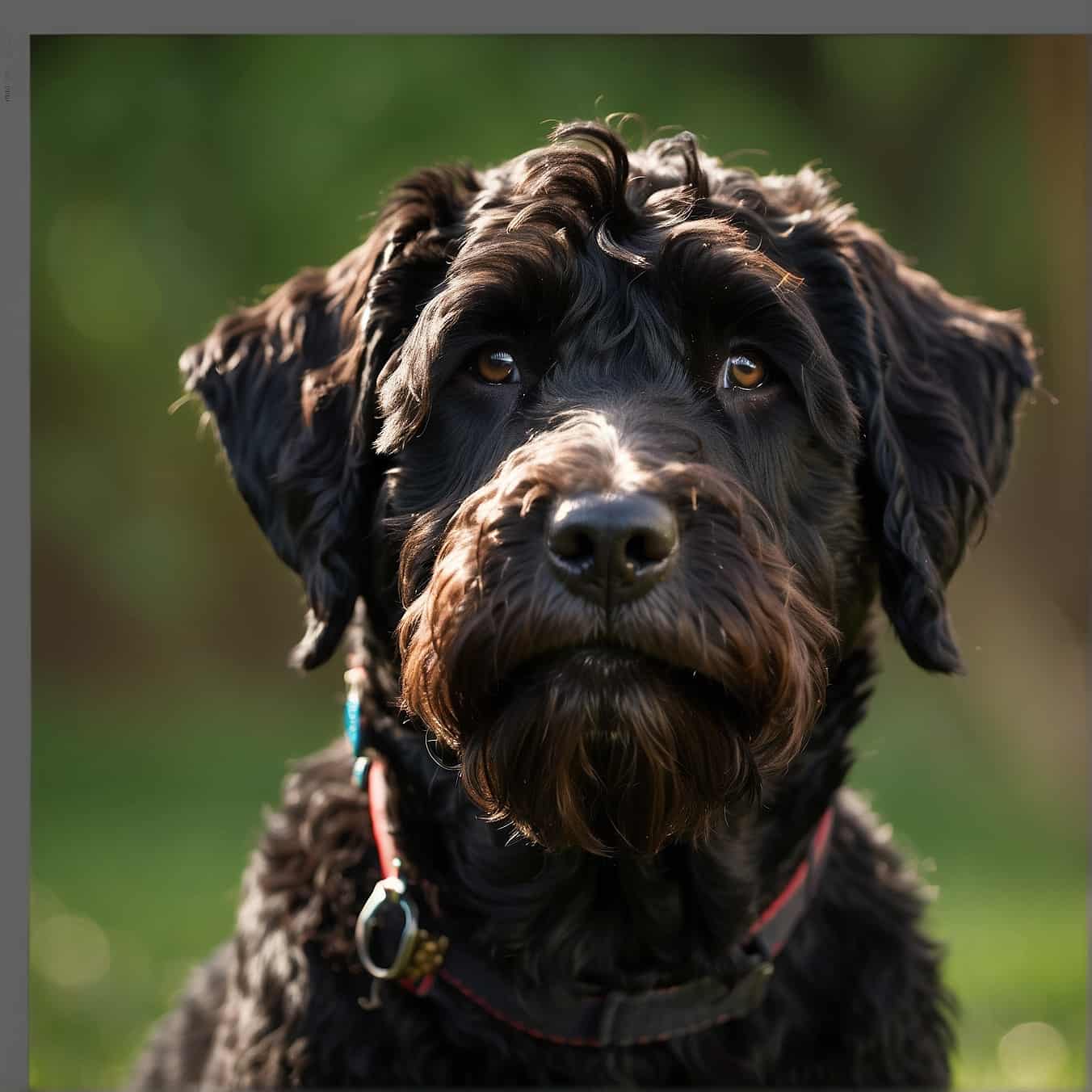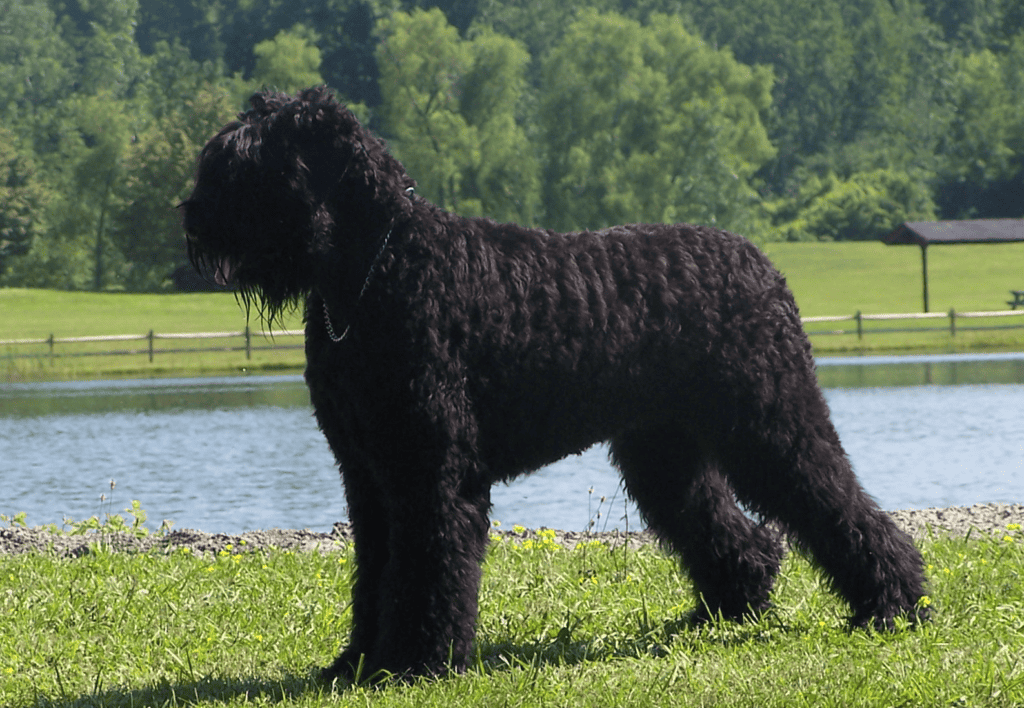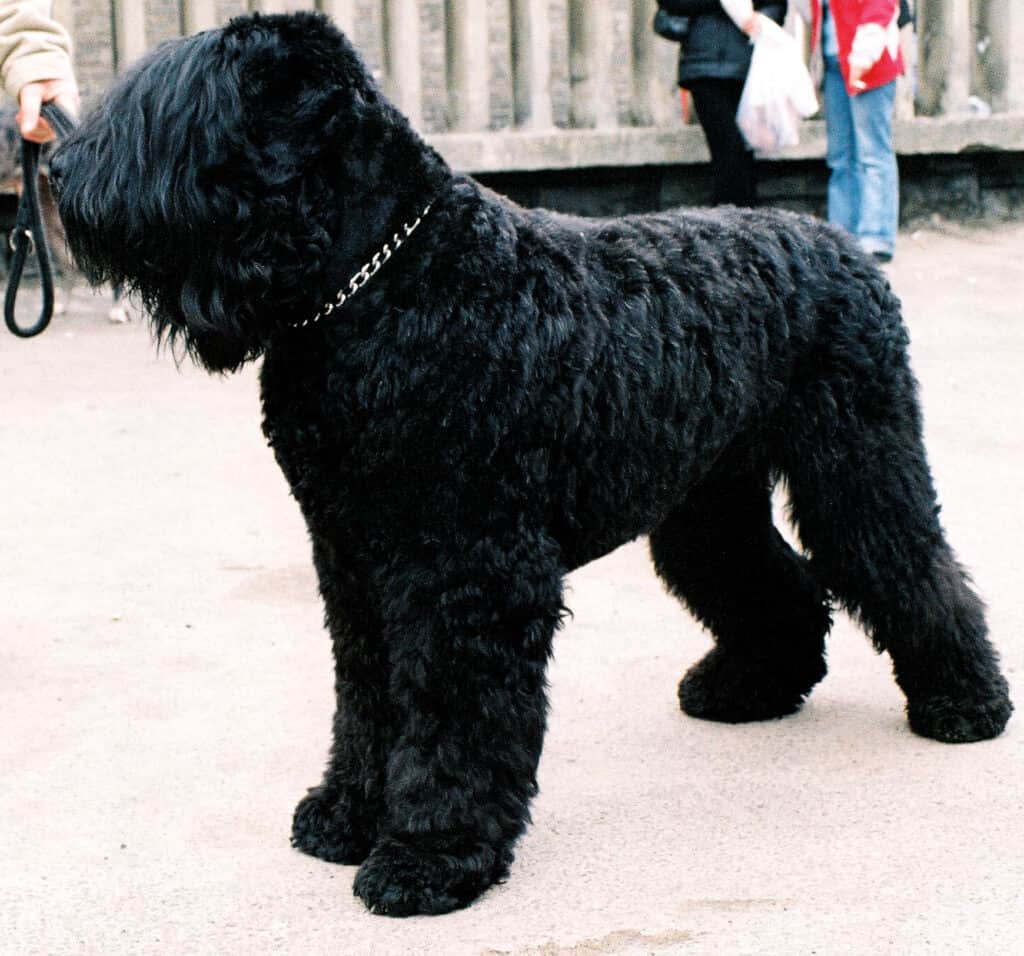The Black Russian Terrier, a powerful and imposing breed, is renowned for its strength, intelligence, and protective nature. Originally developed as a military and working dog in Russia, this loyal and versatile companion combines elegance with a robust build, making it an excellent choice for those seeking a devoted and watchful guardian.

| Category (Explanation) | Breed Information |
|---|---|
| Year of Breed Conception | 1940s |
| Country of Origin | Soviet Union (Russia) |
| Weight (lbs & kg) (Male) | 100-150 lbs (45-68 kg) |
| Weight (lbs & kg) (Female) | 80-120 lbs (36-54 kg) |
| Coat Type | Thick, double coat |
| Color Variations | Black |
| Shedding Level (Low, Moderate, High) | Moderate to High |
| Height (cm & in) | 26-30 inches (66-76 cm) |
| Breed Size | Large |
| Trainability (Low, Moderate, High) | High |
| Mental Needs (Low, Moderate, High) | High |
| Intelligence Level (Low, Moderate, High) | High |
| Energy Level (Low, Moderate, High) | Moderate to High |
| Agility (Low, Moderate, High) | Moderate |
| Loyalty (Low, Moderate, High) | High |
| Playfulness (Low, Moderate, High) | Moderate |
| Exercise Needs | Regular exercise and mental stimulation |
| Guarding Proficiency (Low, Moderate, High) | High |
| Sociability with Children (Low, Moderate, High) | Moderate |
| Barking Level (Low, Moderate, High) | Moderate |
| Digging Tendency (Low, Moderate, High) | Low |
| Destructive Behavior (Low, Moderate, High) | Moderate |
| Drooling Level (Low, Moderate, High) | Low |
| Obedience Level (Low, Moderate, High) | High |
| Apartment Friendly (Yes/No) | Can adapt to apartment living with sufficient exercise |
| Inherent Prey Drive | Moderate |
| Physical Risk to Others (Low, Moderate, High) | Low |
| Travel Fatality Risk (Low, Moderate, High) | Low |
| Allergen Potential | Low |
| Health Concerns (List of Common Health Concerns) | Hip Dysplasia, Heart Issues, Elbow Dysplasia |
| Average Life Expectancy (Life Expectancy in Years) | 10-14 years |
Woof Mastery is reader supported and our articles may contain affiliate links.
Instead of running third party ads that we have no control of we only use links from high-quality companies we are directly partnered with. Making use of these links come at no cost to you our reader, and in many cases have the extra benefit of discounted rates or sign up bonuses.
If you’re interested you can read more about our affiliate policy here.
We appreciate your support and always insure that the products and services we recommend are high-quality, helpful and relevant to the subject at hand!
The Black Russian Terrier has a relatively recent history, with its development beginning in the mid-20th century in the Soviet Union. Bred as a military and working dog, this terrier is a product of careful crossbreeding involving several large breeds, including the Giant Schnauzer and Airedale Terrier. The goal was to create a versatile and robust breed capable of performing various tasks, such as guarding, patrolling, and search and rescue. Today, the Black Russian Terrier is admired for its strength, intelligence, and protective instincts.

The Black Russian Terrier is notable for its imposing presence and strong protective instincts. This breed combines strength and intelligence, making it an exceptional guardian and working dog. Beyond its role as a protector, the Black Russian Terrier is known for its loyalty to its family. Its majestic appearance and versatile skill set contribute to its special status as a devoted and dependable companion.
The Black Russian Terrier’s traditional role is rooted in its development as a military and working dog in the Soviet Union. Bred for versatility, this terrier was tasked with guarding, patrolling, and performing search and rescue operations. Its imposing size, strength, and intelligence made it a valuable asset in various working roles. Today, the Black Russian Terrier’s traditional role continues as a dependable guardian and working dog, reflecting its origins as a dedicated and capable breed with a history of service in demanding roles.
Black Russian Terriers are characterized by their imposing presence and strong protective instincts. While they may appear serious, they are known to be loyal and devoted to their families. These terriers are intelligent and versatile, excelling in various tasks. They are known for their dignified demeanor and are typically reserved with strangers. Black Russian Terriers make dependable guardians and working dogs, combining strength with loyalty. With proper training and socialization, they can form deep bonds with their owners and showcase a gentle and affectionate side.
Black Russian Terriers are known for their protective instincts and loyalty. If not properly trained and socialized, their protective nature can lead to overprotectiveness and wariness of strangers. These terriers may display territorial behavior, emphasizing the importance of early training to establish boundaries. They are intelligent but can be stubborn, requiring consistent and patient training. Leash training is crucial due to their strength and size. Proper introductions are necessary for them to get along with other dogs, particularly of the same sex. With proper handling and socialization, Black Russian Terriers showcase a devoted and protective temperament, making them reliable family guardians.
Black Russian Terriers are large, robust dogs with a strong and imposing presence. They have a massive head, a broad skull, and a well-defined stop. Their eyes are dark and expressive, and their ears are medium-sized and triangular, set high on the head. The breed’s distinctive feature is the thick, double coat that is coarse and black. The coat may have a slight wave but should not be curly. The tail is set high and carried curved over the back. Overall, Black Russian Terriers convey strength, nobility, and a dignified demeanor.
Black Russian Terriers are known for their distinctive black coat, which contributes to their regal and imposing appearance. The coat is typically solid black, and variations in shades of black may exist, creating a luxurious and striking look. The breed’s dark coat enhances its noble and dignified presence.
Black Russian Terriers have a solid black coat as per the breed standard. However, some individuals may develop scattered gray hairs as they age. The breed’s coat is coarse and dense, providing protection in various weather conditions. While the standard emphasizes a solid black color, variations in shades of black and occasional gray hairs may be observed in practice. The solid black appearance contributes to the breed’s imposing and noble presence.
Black Russian Terriers have a low to moderate shedding level. Their dense, coarse coat sheds minimally, and regular grooming is essential to keep the coat healthy. Brushing the coat a few times a week helps remove loose fur and prevents matting. While Black Russian Terriers are not heavy shedders, they do require consistent grooming to manage shedding and maintain the quality of their coat.
Black Russian Terriers have a thick, coarse double coat that requires regular grooming to maintain its quality.
Brushing: Brush their coat several times a week to remove loose hair and prevent mats. Use a slicker brush or a comb suitable for their coat type.
Bathing: Bathe as needed, typically every few months, using a dog shampoo designed for double coats. Rinse thoroughly and dry completely.
Trimming: Regular trimming, especially around the feet and hindquarters, helps maintain their appearance. Consult a professional groomer for guidance.
Ears: Check and clean their ears regularly to prevent wax buildup or infections. Use a damp cotton ball or a veterinarian-recommended ear cleaning solution.
Nails: Keep their nails trimmed to a comfortable length for good foot health.
Teeth: Brush their teeth regularly to prevent dental issues and bad breath.
Black Russian Terriers have a moderate to high activity level. As large and robust dogs, they benefit from regular exercise, including walks, playtime, and activities that engage their mind. Black Russian Terriers enjoy spending time with their owners and may excel in various dog sports and activities. Providing mental stimulation through training sessions and interactive toys is important for their well-being.
Black Russian Terriers are considered highly intelligent. Their problem-solving abilities, coupled with a quick learning pace, make them adaptable to training. With a history rooted in military and working roles, these dogs demonstrate cognitive skills suitable for various tasks. Providing mental stimulation and engaging activities is essential to keep their intelligence sharp.
Black Russian Terriers are highly intelligent and benefit from mental stimulation. Engage them in activities like puzzle toys, interactive games, and obedience training to keep their minds active and prevent boredom.
Social Interaction: They are social dogs and need regular interaction with their family. Loneliness can lead to anxiety, so provide companionship and attention.
Exercise: Regular physical activity is crucial for their mental and physical well-being. Engage them in activities that challenge their bodies and minds.
Enter The Woof Mastery

Before bringing a Black Russian Terrier into your home, consider the following:
Black Russian Terriers, being large and powerful, may pose a physical risk if not properly trained and socialized. Early and consistent training, along with proper socialization, is crucial to ensure they exhibit appropriate behavior around people and other pets. Owners should be responsible and vigilant in managing their interactions.
Black Russian Terriers, being large and protective, can form strong bonds with children in their family. Supervision is crucial, especially due to their size and strength. Proper socialization from an early age is essential to ensure they are well-adjusted around children. Their protective instinct may make them watchful over kids, but early obedience training is vital to teach them appropriate behavior.
Black Russian Terriers can have varied swimming abilities. Some may enjoy the water, while others may be more hesitant. As with any dog, introduce them to water gradually and observe their comfort level. Use a canine life vest if swimming in open water or deep pools to ensure their safety.
Remember that Black Russian Terrier puppies, like all puppies, are eager to please and learn. Positive and consistent training practices will help them become well-behaved, obedient, and happy adult dogs. Building a strong and trusting bond with your puppy through training is a rewarding experience for both you and your canine companion.
Black Russian Terriers are typically calm and reserved, and they do not tend to be excessive barkers. However, they are protective of their families and may bark to alert their owners to perceived threats. Proper socialization and training can help manage their barking tendencies.
Black Russian Terriers thrive in homes with active owners who can provide regular exercise and mental stimulation. They adapt well to various living conditions, including houses with yards and apartments. Socialization is crucial to prevent aggressive behavior. Positive reinforcement training methods work well with this breed.
Traveling with Black Russian Terriers requires attention to their size and the space available. Ensure that carriers or travel crates meet size requirements and provide adequate ventilation. Consider their potential anxiety during travel, and use familiar items to create a comfortable environment. Adequate rest stops, especially for long journeys, are important. For air travel, follow airline policies and choose a crate that complies with safety standards for larger breeds.
Black Russian Terriers, like many breeds, may be prone to specific health concerns. While not all individuals will experience these issues, it’s essential for Black Russian Terrier owners to be aware of potential health problems and collaborate with veterinarians for their pets’ well-being. Common health concerns in Black Russian Terriers include:
Regular veterinary check-ups, a balanced diet, proper exercise, and responsible breeding practices can help mitigate some of these health concerns. It’s crucial for Black Russian Terrier owners to work closely with their veterinarians to monitor their pets’ health and address any issues promptly.
Proper nutrition is crucial for the health and well-being of Black Russian Terriers. Here are some nutritional habits and best practices to consider for this breed:
Breed-Specific Laws (BSL): Black Russian Terriers may be subject to breed-specific laws (BSL) in certain areas. These laws are often enacted at the local or municipal level and can vary widely from one jurisdiction to another.
Types of Restrictions: The specific restrictions imposed on Black Russian Terriers under BSL can include mandatory spaying/neutering, special licensing, liability insurance requirements, muzzling in public, and, in some cases, bans on ownership. The severity of these restrictions depends on local regulations.
Rationale for BSL: BSL is typically implemented based on concerns about public safety and perceived risks associated with specific breeds, often due to incidents involving dog attacks. While Black Russian Terriers are not inherently aggressive, they can be affected by BSL due to their physical resemblance to breeds that are sometimes included in these laws.
Controversy: It’s important to note that BSL is a controversial topic. Critics argue that it unfairly targets breeds rather than addressing individual dog behavior and that responsible ownership and training should be emphasized instead of breed-specific restrictions.
Local Regulations: To determine if there are breed-specific laws or restrictions regarding Black Russian Terriers in your area, you should check with your local animal control or government authorities. Be aware of and comply with any local regulations to ensure that you are in compliance with the law while owning a Black Russian Terrier.
Woof Mastery is reader supported and our articles may contain affiliate links.
Instead of running third party ads that we have no control of we only use links from high-quality companies we are directly partnered with. Making use of these links come at no cost to you our reader, and in many cases have the extra benefit of discounted rates or sign up bonuses.
If you’re interested you can read more about our affiliate policy here.
We appreciate your support and always insure that the products and services we recommend are high-quality, helpful and relevant to the subject at hand!
Myth 1: Black Russian Terriers are Aggressive by Nature
Myth 2: They are Not Suitable for Families
Myth 3: They Require Extensive Grooming
Myth 4: They are High-Maintenance in Terms of Exercise
Myth 5: They are Not Good with Strangers
Myth 6: They are Allergic to Hypoallergenic
Myth 7: They are All the Same
Myth 8: They are Only Suitable for Experienced Owners
Myth 9: They Don’t Get Along with Other Pets
Myth 10: They are Not Good Apartment Dogs
These myths underscore the importance of understanding the individual needs and characteristics of Black Russian Terriers. Responsible ownership, proper training, and socialization contribute to their positive behavior and well-being.
Famous Black Russian Terrier examples are not as widely documented, but these strong and protective dogs can be found in homes where their loyalty and guarding instincts are valued.
The Black Russian Terrier is culturally significant as a breed with a strong and protective nature. Originally developed for military and security purposes, Black Russian Terriers have become valued as loyal companions. Their distinct appearance and versatile abilities contribute to their recognition in popular culture. Black Russian Terriers are symbols of strength and dedication, finding a place as guardians and beloved family members.
The Black Russian Terrier, developed for military and security purposes, does not have a widely recognized historical owner. However, Black Russian Terriers have gained popularity as loyal guardians and family protectors.
Black Russian Terriers, like many dog breeds, have faced specific challenges over the years. Some notable challenges include:
The Black Russian Terrier is a relatively modern breed developed in Russia. It is believed to have been created through the combination of several large working breeds. Contributing breeds may include:
Black Russian Terriers are a majestic and versatile breed that brings strength and elegance to any household. Their protective instincts and loyalty make them excellent guardians, while their adaptability allows them to thrive in various living environments. With a dignified presence and intelligence, they form strong bonds with their families, offering both companionship and security. Engaging with them in activities and providing mental stimulation enhances their well-being and reinforces the special connection they share with their owners.